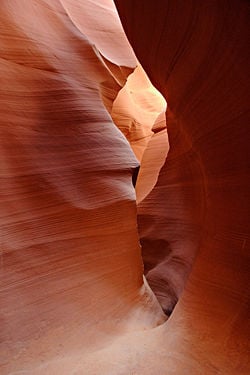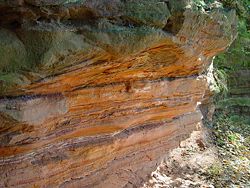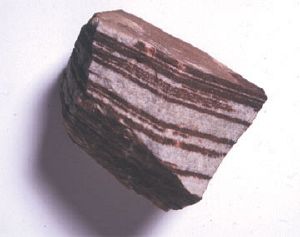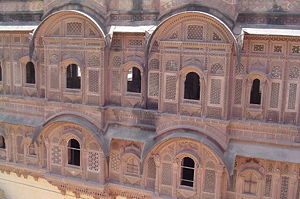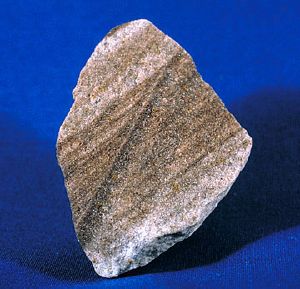Difference between revisions of "Sandstone" - New World Encyclopedia
(imported latest version of article from Wikipedia) |
Rosie Tanabe (talk | contribs) |
||
| (10 intermediate revisions by 5 users not shown) | |||
| Line 1: | Line 1: | ||
| − | [[Image:Lower antelope 2 md.jpg|thumb|250px|right|Red sandstone interior of | + | {{Copyedited}}{{Paid}}{{Images OK}}{{Submitted}}{{Approved}} |
| − | '''Sandstone''' is a [[sedimentary rock]] composed mainly of [[sand]]-size [[mineral]] or rock [[grain size|grains]]. Most sandstone is composed of [[quartz]] and/or [[feldspar]] because these are the most common minerals in the | + | [[Image:Lower antelope 2 md.jpg|thumb|250px|right|Red '''sandstone''' interior of Lower Antelope Canyon, Arizona, worn smooth due to erosion by flash flooding over millions of years]] |
| + | '''Sandstone''' is a [[sedimentary rock]] composed mainly of [[sand]]-size [[mineral]] or rock [[grain size|grains]]. Most sandstone is composed of [[quartz]] and/or [[feldspar]], because these are the most common minerals in the [[Earth]]'s crust. Like sand, sandstone may be any color, but the most common colors are tan, brown, yellow, red, gray, and white. | ||
| + | {{toc}} | ||
| + | Some sandstones are resistant to weathering, yet are easy to work. This makes sandstone a common [[building material|building]] and [[pavement (material)|paving]] material. Given the hardness of the individual grains, uniformity of grain size, and [[friability]]<ref>Friability is the degree to which a solid can be easily crumbled into small particles.</ref> of its structure, sandstone is an excellent material from which to make [[grindstone (tool)|grindstone]]s for sharpening blades and other implements. Non-friable sandstone can be used to make grindstones for grinding grain (such as [[gritstone]]). | ||
| − | + | == Sandstone formations == | |
| − | Rock formations that are primarily sandstone usually allow percolation of water and are porous enough to store large quantities, | + | Rock formations that are primarily sandstone usually allow percolation of water and are porous enough to store large quantities. For this reason, they are valuable as [[aquifer]]s. Fine-grained aquifers, such as sandstones, are more apt to filter out pollutants from the surface than are rocks with cracks and crevices, such as [[limestone]]s or other rocks fractured by seismic activity. |
| + | |||
| + | Sandstone beds often form highly visible cliffs and other [[topography|topographic]] features. As a result, certain colors of sandstone have been strongly identified with certain regions of the world. | ||
== Origins == | == Origins == | ||
| − | [[Image:Stadtroda Sandstein.jpg|thumb|250px|Sandstone near | + | [[Image:Stadtroda Sandstein.jpg|thumb|250px|Sandstone near Stadtroda, Germany]] |
| − | Sandstones are ''clastic'' in origin (as opposed to ''organic'', like [[chalk]] and [[coal]], or ''chemical'', like [[gypsum]] and [[jasper]]). They are formed from [[cementation|cemented]] grains that may | + | |
| + | Sandstones are ''clastic'' in origin (as opposed to ''organic'', like [[limestone|chalk]] and [[coal]], or ''chemical'', like [[gypsum]] and [[jasper]]). They are formed from [[cementation|cemented]] grains that may be fragments of a pre-existing rock or crystals of a single mineral. The cements binding these grains together are typically [[calcite]], [[clay]]s and [[silica]]. [[Grain size]]s in sands are in the range of 0.1 to 2 millimeters. Rocks with smaller grain sizes include [[siltstone]]s and [[shale]]s and are typically called ''argillaceous'' sediments. Clays and rocks with larger grain sizes include both [[breccia]]s and [[conglomerate (geology)|conglomerate]]s and are termed ''rudaceous'' sediments. | ||
| + | |||
[[Image:SandstoneUSGOV.jpg|thumb|left|Sandstone with iron oxide bands]] | [[Image:SandstoneUSGOV.jpg|thumb|left|Sandstone with iron oxide bands]] | ||
| − | |||
| − | The | + | The formation of sandstone involves two principal stages. First, a layer or layers of sand accumulates as the result of [[sedimentation]], either from water (as in a [[river]], [[lake]], or [[sea]]) or from air (as in a [[desert]]). Typically, sedimentation occurs by the sand settling out from suspension, that is, ceasing to be rolled or bounced along the bottom of a body of water (such as a sea or river) or ground surface (such as in a desert or sand dune region). Finally, once it has accumulated, the sand becomes sandstone when it is [[compaction|compacted]] by pressure of overlying deposits and cemented by the precipitation of minerals within the pore spaces between sand grains. The most common cementing materials are silica and [[calcium carbonate]], which are often derived either from dissolution or from alteration of the sand after it was buried. |
| − | [[ | + | The colors of sandstone are usually tan or yellow, derived from a blend of the clear quartz with the dark amber feldspar content of the sand. A predominant additional colorant in the southwestern United States is [[iron oxide]], which imparts reddish tints, ranging from pink to dark red ([[terra cotta]]), with additional [[manganese]] imparting a purplish hue. Red sandstones are also seen in the Southwest and West of [[England]], as well as central [[Europe]] and [[Mongolia]]. |
| − | * Terrestrial environments | + | Deposition from sand dunes can be recognized by irregular and fluidly shaped weathering patterns and wavy coloration lines when sectioned. Water deposition forms more regular blocks when weathered. The regularity of the latter favors use as a source for [[masonry]], either as a primary building material or as a facing stone, over other construction. |
| + | |||
| + | The environment of deposition is crucial in determining the characteristics of the resulting sandstone. In finer detail, these characteristics include the ''[[grain size]]'', ''sorting'', and ''composition'' of the stone, and in more general detail, they include the rock geometry and sedimentary structures. Principal environments of deposition may be split between terrestrial and marine, as illustrated by the following broad groupings: | ||
| + | |||
| + | [[Image:Sand stone.JPG|300px|thumb|right|Hawa Mahal in Jaipur, India, is an example of sandstone-based building architecture]] | ||
| + | |||
| + | * Terrestrial environments: | ||
# Rivers ([[levee]]s, point bars, channel sands) | # Rivers ([[levee]]s, point bars, channel sands) | ||
# Alluvial fans | # Alluvial fans | ||
| Line 23: | Line 35: | ||
# Deserts (sand dunes and ergs) | # Deserts (sand dunes and ergs) | ||
| − | * Marine environments | + | * Marine environments: |
| − | # [[River | + | # [[River deltas]] |
# Beach and shoreface sands | # Beach and shoreface sands | ||
| − | # Tidal deltas | + | # Tidal deltas and flats |
# Offshore bars and sand waves | # Offshore bars and sand waves | ||
# Storm deposits (tempestites) | # Storm deposits (tempestites) | ||
| Line 33: | Line 45: | ||
== Types of sandstone == | == Types of sandstone == | ||
[[Image:Sandstone(quartz)USGOV.jpg|thumb|Sandstone with quartz]] | [[Image:Sandstone(quartz)USGOV.jpg|thumb|Sandstone with quartz]] | ||
| + | |||
Once the geological characteristics of a sandstone have been established, it can then be assigned to one of three broad groups: | Once the geological characteristics of a sandstone have been established, it can then be assigned to one of three broad groups: | ||
| − | * ''arkosic'' sandstones, which have a high ( | + | * ''arkosic'' sandstones, which have a high (greater than 25 percent) feldspar content and a composition similar to [[granite]]. |
| − | * ''quartzose'' sandstones (also known as 'beach sand') which have a high ( | + | * ''quartzose'' sandstones (also known as 'beach sand'), which have a high (greater than 90 percent) quartz content. Sometimes these sandstones are termed "[[Quartzites]]"—for example, the Tuscarora Quartzite of the [[Ridge-and-valley Appalachians]]. |
* ''argillaceous'' sandstones, such as [[greywacke]], which have a significant [[clay]] or [[silt]] content. | * ''argillaceous'' sandstones, such as [[greywacke]], which have a significant [[clay]] or [[silt]] content. | ||
| − | == | + | ==Gallery== |
| − | |||
| − | |||
| − | |||
| − | |||
| − | |||
| − | |||
<gallery> | <gallery> | ||
Image:USDA Mineral Sandstone 93c3955.jpg|Prepared sample of sandstone | Image:USDA Mineral Sandstone 93c3955.jpg|Prepared sample of sandstone | ||
Image:Sandstone Concretion.jpg|A natural sandstone formation composed of cemented quartz sand | Image:Sandstone Concretion.jpg|A natural sandstone formation composed of cemented quartz sand | ||
| − | Image:Wall Patterns.jpg|Sandstone patterns on | + | Image:Wall Patterns.jpg|Sandstone patterns on a chamber wall in Petra |
| − | Image:Arbroath_Abbey1.jpg| | + | Image:Arbroath_Abbey1.jpg|Arbroath Abbey, showing distinctive sandstone coloring |
| − | |||
</gallery> | </gallery> | ||
==See also== | ==See also== | ||
| − | |||
| − | |||
*[[Geology]] | *[[Geology]] | ||
| − | *[[ | + | *[[Granite]] |
| − | *[[ | + | *[[Limestone]] |
| − | *[[ | + | *[[Mineral]] |
| − | *[[ | + | *[[Rock (geology)]] |
| + | *[[Sand]] | ||
| + | |||
| + | ==Notes== | ||
| + | <references/> | ||
| + | |||
| + | == References == | ||
| + | *Boggs, J. R. 2000. ''Principles of Sedimentology and Stratigraphy'', 3rd ed. Toronto: Merril Publishing Company. ISBN 0130996963 | ||
| + | *Folk, R. L. 1965. ''Petrology of Sedimentary Rocks'', 2nd ed. 1981. Austin, TX: Hemphill’s Bookstore. ISBN 0914696149 | ||
| + | *Pettijohn, F. J., P. E. Potter and R. Siever. 1987. ''Sand and Sandstone'', 2nd ed. Springer-Verlag. ISBN 0387963502 | ||
| + | *Scholle, P. A. 1978. ''A Color Illustrated Guide to Constituents, Textures, Cements, and Porosities of Sandstones and Associated Rocks''. American Association of Petroleum Geologists. ISBN 0891813047 | ||
| + | *Scholle, P. A., and D. Spearing. 1982. ''Sandstone Depositional Environments: Clastic Terrigenous Sediments''. American Association of Petroleum Geologists. ISBN 0891813071 | ||
| + | |||
| − | [[Category: | + | [[Category:Physical sciences]] |
| − | [[Category: | + | [[Category:Earth sciences]] |
| − | |||
| − | + | {{credit|75655276}} | |
| − | |||
| − | |||
| − | |||
| − | |||
| − | |||
| − | |||
| − | |||
| − | |||
| − | |||
| − | |||
| − | |||
| − | |||
| − | |||
| − | |||
| − | |||
| − | |||
| − | |||
| − | |||
| − | |||
| − | |||
| − | |||
| − | |||
| − | |||
| − | |||
| − | |||
| − | |||
Latest revision as of 01:20, 21 April 2023
Sandstone is a sedimentary rock composed mainly of sand-size mineral or rock grains. Most sandstone is composed of quartz and/or feldspar, because these are the most common minerals in the Earth's crust. Like sand, sandstone may be any color, but the most common colors are tan, brown, yellow, red, gray, and white.
Some sandstones are resistant to weathering, yet are easy to work. This makes sandstone a common building and paving material. Given the hardness of the individual grains, uniformity of grain size, and friability[1] of its structure, sandstone is an excellent material from which to make grindstones for sharpening blades and other implements. Non-friable sandstone can be used to make grindstones for grinding grain (such as gritstone).
Sandstone formations
Rock formations that are primarily sandstone usually allow percolation of water and are porous enough to store large quantities. For this reason, they are valuable as aquifers. Fine-grained aquifers, such as sandstones, are more apt to filter out pollutants from the surface than are rocks with cracks and crevices, such as limestones or other rocks fractured by seismic activity.
Sandstone beds often form highly visible cliffs and other topographic features. As a result, certain colors of sandstone have been strongly identified with certain regions of the world.
Origins
Sandstones are clastic in origin (as opposed to organic, like chalk and coal, or chemical, like gypsum and jasper). They are formed from cemented grains that may be fragments of a pre-existing rock or crystals of a single mineral. The cements binding these grains together are typically calcite, clays and silica. Grain sizes in sands are in the range of 0.1 to 2 millimeters. Rocks with smaller grain sizes include siltstones and shales and are typically called argillaceous sediments. Clays and rocks with larger grain sizes include both breccias and conglomerates and are termed rudaceous sediments.
The formation of sandstone involves two principal stages. First, a layer or layers of sand accumulates as the result of sedimentation, either from water (as in a river, lake, or sea) or from air (as in a desert). Typically, sedimentation occurs by the sand settling out from suspension, that is, ceasing to be rolled or bounced along the bottom of a body of water (such as a sea or river) or ground surface (such as in a desert or sand dune region). Finally, once it has accumulated, the sand becomes sandstone when it is compacted by pressure of overlying deposits and cemented by the precipitation of minerals within the pore spaces between sand grains. The most common cementing materials are silica and calcium carbonate, which are often derived either from dissolution or from alteration of the sand after it was buried.
The colors of sandstone are usually tan or yellow, derived from a blend of the clear quartz with the dark amber feldspar content of the sand. A predominant additional colorant in the southwestern United States is iron oxide, which imparts reddish tints, ranging from pink to dark red (terra cotta), with additional manganese imparting a purplish hue. Red sandstones are also seen in the Southwest and West of England, as well as central Europe and Mongolia.
Deposition from sand dunes can be recognized by irregular and fluidly shaped weathering patterns and wavy coloration lines when sectioned. Water deposition forms more regular blocks when weathered. The regularity of the latter favors use as a source for masonry, either as a primary building material or as a facing stone, over other construction.
The environment of deposition is crucial in determining the characteristics of the resulting sandstone. In finer detail, these characteristics include the grain size, sorting, and composition of the stone, and in more general detail, they include the rock geometry and sedimentary structures. Principal environments of deposition may be split between terrestrial and marine, as illustrated by the following broad groupings:
- Terrestrial environments:
- Rivers (levees, point bars, channel sands)
- Alluvial fans
- Glacial outwash
- Lakes
- Deserts (sand dunes and ergs)
- Marine environments:
- River deltas
- Beach and shoreface sands
- Tidal deltas and flats
- Offshore bars and sand waves
- Storm deposits (tempestites)
- Turbidites (submarine channels and fans)
Types of sandstone
Once the geological characteristics of a sandstone have been established, it can then be assigned to one of three broad groups:
- arkosic sandstones, which have a high (greater than 25 percent) feldspar content and a composition similar to granite.
- quartzose sandstones (also known as 'beach sand'), which have a high (greater than 90 percent) quartz content. Sometimes these sandstones are termed "Quartzites"—for example, the Tuscarora Quartzite of the Ridge-and-valley Appalachians.
- argillaceous sandstones, such as greywacke, which have a significant clay or silt content.
Gallery
See also
Notes
- ↑ Friability is the degree to which a solid can be easily crumbled into small particles.
ReferencesISBN links support NWE through referral fees
- Boggs, J. R. 2000. Principles of Sedimentology and Stratigraphy, 3rd ed. Toronto: Merril Publishing Company. ISBN 0130996963
- Folk, R. L. 1965. Petrology of Sedimentary Rocks, 2nd ed. 1981. Austin, TX: Hemphill’s Bookstore. ISBN 0914696149
- Pettijohn, F. J., P. E. Potter and R. Siever. 1987. Sand and Sandstone, 2nd ed. Springer-Verlag. ISBN 0387963502
- Scholle, P. A. 1978. A Color Illustrated Guide to Constituents, Textures, Cements, and Porosities of Sandstones and Associated Rocks. American Association of Petroleum Geologists. ISBN 0891813047
- Scholle, P. A., and D. Spearing. 1982. Sandstone Depositional Environments: Clastic Terrigenous Sediments. American Association of Petroleum Geologists. ISBN 0891813071
Credits
New World Encyclopedia writers and editors rewrote and completed the Wikipedia article in accordance with New World Encyclopedia standards. This article abides by terms of the Creative Commons CC-by-sa 3.0 License (CC-by-sa), which may be used and disseminated with proper attribution. Credit is due under the terms of this license that can reference both the New World Encyclopedia contributors and the selfless volunteer contributors of the Wikimedia Foundation. To cite this article click here for a list of acceptable citing formats.The history of earlier contributions by wikipedians is accessible to researchers here:
The history of this article since it was imported to New World Encyclopedia:
Note: Some restrictions may apply to use of individual images which are separately licensed.
